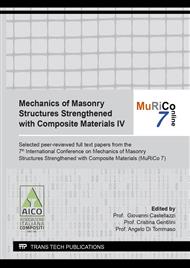[1]
Santamouris, M. (2016). Innovating to zero the building sector in Europe: Minimising the energy consumption, eradication of the energy poverty and mitigating the local climate change. Solar Energy, 128, 61-94.
DOI: 10.1016/j.solener.2016.01.021
Google Scholar
[2]
Al-Saadi, N. T. K., Mohammed, A., Al-Mahaidi, R., & Sanjayan, J. (2019). A state-of-the-art review: Near-surface mounted FRP composites for reinforced concrete structures. Construction and Building Materials, 209, 748-769.
DOI: 10.1016/j.conbuildmat.2019.03.121
Google Scholar
[3]
Del Zoppo, M., Di Ludovico, M., & Prota, A. (2019). Analysis of FRCM and CRM parameters for the in-plane shear strengthening of different URM types. Composites Part B: Engineering, 171, 20-33.
DOI: 10.1016/j.compositesb.2019.04.020
Google Scholar
[4]
Aiello, M. A., Cascardi, A., Ombres, L., & Verre, S. (2020). Confinement of masonry columns with the FRCM-system: Theoretical and experimental investigation. Infrastructures, 5(11), 1-14.
DOI: 10.3390/infrastructures5110101
Google Scholar
[5]
Longo, F., Lassandro, P., Moshiri, A., Phatak, T., Aiello, M. A., & Krakowiak, K. J. (2020). Lightweight geopolymer-based mortars for the structural and energy retrofit of buildings. Energy and Buildings, 225, 110352.
DOI: 10.1016/j.enbuild.2020.110352
Google Scholar
[6]
UNI, E. (2001). 1052-1. Methods of test for masonry - Determination of compressive strength.
Google Scholar
[7]
UNI, E. (2007). 771-1:2015. Specification for masonry units - Part 1: Clay masonry units.
Google Scholar
[8]
UNI, E. (2007). 1015-11. Methods of test for mortar for masonry - Part 11: Determination of flexural and compressive strength of hardened mortar.
DOI: 10.3403/01905442
Google Scholar
[9]
Consiglio Superiore dei Lavori Pubblici, C. S. (2015). Linea Guida per la identificazione, la qualificazione ed il controllo di accettazione di compositi fibrorinforzati a matrice inorganica (FRCM) da utilizzarsi per il consolidamento strutturale di costruzioni esistenti. In Italian. Standards for the Qualification of Fabric Reinforced Cementitious Mortar (FRCM) composites for the reinforcement of existing structures.
DOI: 10.3221/igf-esis.12.04
Google Scholar
[10]
ASTM C518-04, Standard Test Method for Steady-State Thermal Transmission Properties by Means of the Heat Flow Meter Apparatus, ASTM International, West Conshohocken, PA, (2004).
DOI: 10.1520/c0518
Google Scholar
[11]
ASTM E1530-06, Standard Test Method for Evaluating the Resistance to Thermal Transmission of Materials by the Guarded Heat Flow Meter Technique, West Conshohocken, PA, (2006).
DOI: 10.1520/e1530-99
Google Scholar
[12]
ASTM E519 / E519M-10, Standard Test Method for Diagonal Tension (Shear) in Masonry Assemblages, ASTM International, West Conshohocken, PA, 2010, www.astm.org.
Google Scholar
[13]
Howell, J. R., Siegel, R., & Mengüç, M. P. (1969). Thermal radiation heat transfer. National Aeronautics and Space Administration.
Google Scholar
[14]
Albatici, R., Passerini, F., Tonelli, A. M., & Gialanella, S. (2013). Assessment of the thermal emissivity value of building materials using an infrared thermovision technique emissometer. Energy and buildings, 66, 33-40.
DOI: 10.1016/j.enbuild.2013.07.004
Google Scholar
[15]
Emmel, M. G., Abadie, M. O., & Mendes, N. (2007). New external convective heat transfer coefficient correlations for isolated low-rise buildings. Energy and Buildings, 39(3), 335-342.
DOI: 10.1016/j.enbuild.2006.08.001
Google Scholar
[16]
Donatelli, A., Aversa, P., & Luprano, V. A. M. (2016). Set-up of an experimental procedure for the measurement of thermal transmittances via infrared thermography on lab-made prototype walls. Infrared Physics & Technology, 79, 135-143.
DOI: 10.1016/j.infrared.2016.10.005
Google Scholar
[17]
Kontoleon, K. J., Theodosiou, T. G., & Tsikaloudaki, K. G. (2013). The influence of concrete density and conductivity on walls' thermal inertia parameters under a variety of masonry and insulation placements. Applied energy, 112, 325-337.
DOI: 10.1016/j.apenergy.2013.06.029
Google Scholar
[18]
Decreto interministeriale 26 giugno 2015 - Applicazione delle metodologie di calcolo delle prestazioni energetiche e definizione delle prescrizioni e dei requisiti minimi degli edifici. Dalla Direttiva europea 2002/91/CE. [In Italian].
Google Scholar
[19]
UNI10351-1994 Materiali da costruzione. Conduttività termica e permeabilità al vapore,. 31 marzo 1994. [In Italian].
Google Scholar


